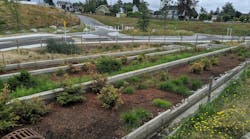Turning a Liability into an Asset
In December 2011, city officials made the difficult decision to evacuate the 12 units in a Moraine, Ohio, apartment complex that were the closest to Holes Creek. Upstream development and years of erosion had eaten away at the creek bank, creating a threat to the building’s foundation. Randy Humbert—president of the residential construction division of Miller Valentine Group, which owns the Dayton-area apartment complex—needed to find a way to stabilize the creek bank quickly. Still, the solution that engineers designed, and the speed with which it was installed, surprised him.
Rising waters
“When we originally constructed the apartments here, the creek was about 20 ft further away,” said Humbert.
During the preceding few years, a road was widened and some land was cleared, both of which caused the water volume in storm events to rise. “Sediment and realignment upstream put us in the cross hairs. Any time there was a heavy rain, it just ate away at the stream bank—undercutting and caving it in and washing it away,” Humbert said.
“Residents had been losing green space over the last few years,” said Jeff Barrow, P.E., president of Civil Solutions Associates of Cincinnati. “But when the creek intrusion started affecting the parking lot and threatening the building foundations, something had to be done.”
The 12 units in the building closest to Stone Creek were evacuated by order of the City of Moraine. Residents were allowed to move into other onsite units, but finding a solution that would get residents back into their homes as soon as possible was a priority.
Holding strong
The owners and engineers working on the project chose Redi-Rock for four reasons:
1. Gravity design: Since the stream had advanced to within 8 ft of the apartment building’s foundation, developers needed a way to stabilize the stream banks without compromising the building’s foundation and the adjacent parking lot. “We needed a block design that would allow us to create a 16-ft-tall unreinforced slope, so we used a wall design and restored the slope to pre-flood conditions,” Barrow said.
The wall design included Redi-Rock 41-in. gravity blocks (which weigh as much as a Clydesdale) and Redi-Rock 9-in. setback blocks, which increase the batter of a wall, allowing a taller gravity wall to be built. At its tallest point, the wall stands 19.5 ft tall, but the bottom 3–3.5 ft are buried.
2. Competitive pricing: “We looked at several other possibilities, like a gabion basket wall or a steel pylon curtain wall, or riprap. But when we ran the numbers, Redi-Rock was as economical as any of those other systems and, quite frankly, was easier to install,” Humbert said.
3. Fast installation: Redi-Rock blocks stack like giant Lego bricks and can be installed by a small crew with a piece of heavy machinery. “Obviously, speed of installation was important because we were working against nature,” said Humbert. “If a rainfall came and the stream rose quickly, it could have destroyed all the work we’d done and set us back even further. The speed at which [the workers] were able to put it up was very surprising.”
Installation of 5,100 sq ft of Redi-Rock walls was completed in just eight days.
4. Aesthetics: Even though creating an aesthetic wall was not a primary goal of the project, “It was clearly a bonus that it’s a very nice looking wall,” said Humbert.
“The end product made a substantial impact and improved the overall image of the development,” said Barrow. “It turned the liability of an encroaching stream into a visual asset.”


